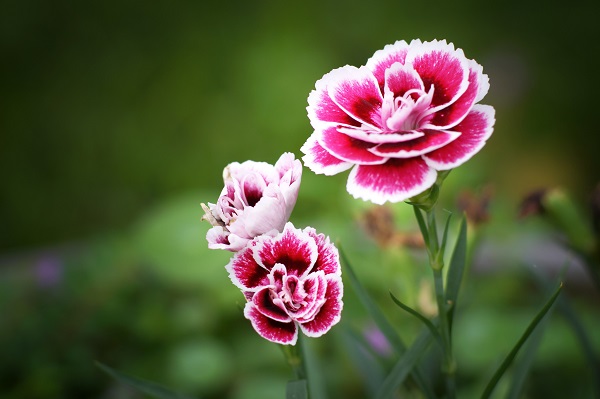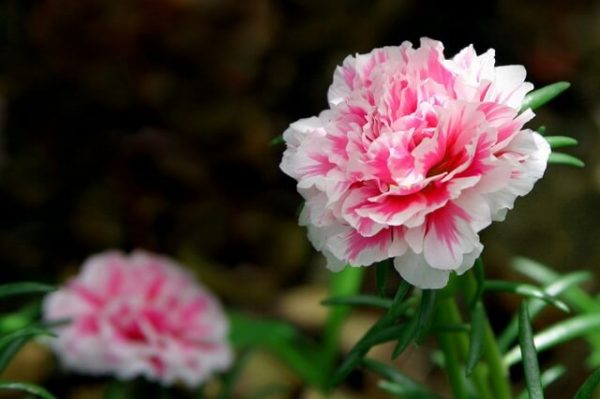The carnation (Dianthus caryophyllus) is a perennial grown widely for use as a cut flower. Who among us hasn’t been gifted with a carnation flower corsage, boutonniere, or bouquet? Carnation plants are a variety of dianthus, and are also known as pinks because their natural color range includes many shades of pink, white, coral, and red. White carnations are frequently dyed in various colors for holidays (like green for Saint Patrick’s Day or pastel colors for Easter).
True carnations have a ruffly appearance that hold their own in flower arrangements, and they have a distinctive, spicy, faintly clove-like scent loved by many. Plant them in the early spring (around April or May) a couple of weeks after the last frost. If you’re lucky, you’ll see a blossom in six weeks, but more typically, these plants don’t flower in their first year, so patience is key. Keep in mind that carnations are mildly toxic to animals.1
The dianthus has been widely cultivated for more than two thousand years, based on its mention in ancient Greek texts. Pinning down its native locale is difficult, but some botanists theorize it originated somewhere in the Mediterranean. Dianthus translates from the Greek as “divine flower,” while “carnation” is a Latin word meaning “crown” or “garland.”
Traditionally, carnations symbolize captivation, distinction, and love, especially motherly love. The flower is associated with the tears of the virgin Mary in Christian legend, which is why it has such a strong connection to the maternal.

Dianthus carophyllus does best in USDA hardiness zones 7 to 10, so it is not quite as cold hardy as other dianthus varieties. Although dianthus are sometimes known as short-lived perennials, if they have the right conditions, you can expect years of beauty and fragrance from them.
A carnation’s color is often vibrant and makes a beautiful choice for the cottage garden. Easy seasonal care includes deadheading them after their first bloom, which helps ensure reblooming later in the season. They do best without mulch, but if you do use mulch, opt for a natural product instead of dyed mulches. Carnations, like all dianthus, are deer-resistant, but rabbits may enjoy nibbling on the leaves.
Although they do best in full sun, carnations are fine with some partial shade. Too much bright afternoon sun might cause the petals of brightly colored carnations to fade. Plant your carnations where they’ll get morning sun, if possible, to keep the flowers looking fresh and the colors bright.
Carnations require excellent drainage and alkaline soil, which is also referred to as “sweet” soil. Alkaline soil tends to have slightly higher concentrations of calcium, magnesium, and sodium. If your soil tends to be acidic, adding a bit of lime when planting carnations will get them off to a good start.
Dianthus carophyllus are relatively drought tolerant but they need regular water in spring when their flower buds are forming. During dry spells in summer, they may need an extra drink of water. Water at the base of the plant. However, be careful not to overwater, or the leaves may yellow and the flower petals may droop or fall off.
Carnations like a warm environment, but will wilt in extreme heat. They do best in low humidity. However, an occasional light spritz of cool water during very hot weather may help cool them down a bit.
Newly growing carnations can benefit from a small amount of slow-release fertilizer. A quick-release fertilizer can burn the plant. Overfertilization can cause the carnation’s roots to shrivel, which may trigger conditions for root rot.
There are three basic types of carnations available to the home grower: large-flowered carnations (also known as standard carnations), dwarf-flowered carnations, and spray or miniature carnations. The following cultivars are a very small sample of the thousands of varieties available.

PV / Flickr / CC BY 2.0
- Chabaud carnations: These large standard carnations come in a variety of cultivars, including “Jeanne Dionis” (white), “Benigna” (picotee white-edged with magenta), “Aurora” (range of medium to dark pink), “Orange Sherbet” (warm, deep coral), and “La France” (classic pale pink).
Longsheds / Flickr/ CC BY 2.0
- Spray carnations: These cultivars include “Elegance” (white-edged pink), “Exquisite” (white-edged purple), and “Rony” (scarlet red).
- Full double-petaled carnations: Some excellent smaller varieties with full double-petaled flowers include “Appleblossom Burst” (shades of pink with deep red centers), “Double Bubble” (bright bubble gum pink), “Grace Bay” (cream flower heads edged in magenta), and “Rosy Cheeks” (medium pink with orange centers).
If you want to plant carnations from seed, be sure to select cultivars suitable for your growing zone. You can start them indoors in a sunny window, six to eight weeks before the last frost date for your area. You may also sow carnations outdoors after frost season has ended, but it’s unlikely they will bloom that first year. Do this only if your growing zone is at least USDA 6, to be sure they will survive the winter as a perennial.
Plant them in potting soil, sprinkling seeds over the surface, and cover very lightly with soil. Keep them moist with a mist sprayer, and wrap the planting container loosely with plastic to create a greenhouse effect. Seedlings should germinate within three days. Once they form two or three leaves, put them in their own containers, and let them get at least 4 to 5 inches tall before transplanting outside, once frost danger has passed.
In addition to growing carnations from seed, there are two other ways to propagate the plant. Grow them from cuttings or division.

How to propagate carnations from cuttings:
A majority of professional carnation farmers grow carnations from cuttings. To do this, they use cuttings from terminal flowers (ones that form at the end of the sprout rather than where the stem and branch meet). These cuttings should be 4 to 6 inches. The propagation requires them to be inserted into pure sand and in 25 to 30 days they’ll be ready for transplantation.
How to propagate carnations with division:
It’s easy to neaten up old, raggedy carnation plants in your garden by division. Dividing them every two to three years will revive the plants and keep them healthy, as well. Take the following steps:
- Dig up a clump of carnations from the ground.
- Use your hands to gently pull apart the plant, including the roots, so you have a few segments of carnations.
- Check the roots for any rot that needs to be removed by disinfected snippers.
- Replant the segments back into the ground in a sunny spot and water well.
Potted carnations can be soft and pretty on a patio. Choose pots of any material with drainage holes. Make sure the pot is large enough—an 8-inch pot will be perfect, or select one that is one size up from the plant’s current pot. Remove from the old container carnations that are root bound or need rejuvenating. Knock off the old dirt from the roots and check for any rotted roots you can snip off with a sanitized cutting tool. Repot the carnation into the container filled with good quality potting mix and water well but do not oversaturate or make the soil soggy.
Carnations are cold hardy and can easily survive tough winters. To ensure survival, cut the plants down to a few inches from the ground before winter hits.
Carnations are vulnerable to pests, including aphids, spider mites, and cutworms. Insecticidal soap can control aphids and spider mites. Cutworms are a bit more complicated to eradicate, but you can try manually removing them or protecting your plants with collars.
Carnations are susceptible to fungal diseases, such as leaf spot, rust, and botrytis flower rot. The plant may also be the target of bacterial wilt (symptoms include oozing) and vascular wilt (discoloration).
To enjoy a proliferation of ruffle-edged carnation blooms, it’s best to plant them in a spot where they will receive at least six hours of sun a day. Carnations prefer well-draining soil to bloom or they may flower, but they will look discolored.
Sometimes carnation buds are tight or not fully open. These two methods are easiest for cut carnations or carnations in a container. To open a resistant bloom, try brushing open the bud with the flower head of an older carnation, which provides just the right soft touch to motivate the resistant bloom to open. Brush from the center of the flower to its outer edges to help it “bloom.” If the bud is closed but looks like it wants to open, gently squeeze the base of the bud to help loosen up any tightness, which can help give it a little push to bloom.
Dianthus are fairly easy to grow and care for. But along the way you may spot some problems, including the following:
If parts of the flower are browning, but also papery to the touch, along with spots of gray fuzz, the plants are suffering from botrytis flower rot. Rust and leaf spot could also cause browning and leaf curl. In any of these cases, remove the rotted parts and do not water plants from overhead to avoid getting the buds and leaves overly wet. Space the plants to improve air circulation.
If leaves are becoming very light yellow, check for spider mites and their fine webs on the underside of the leaves. Use insecticidal soap to control the issue. Aphids could also cause the discoloration in the leaves.
It’s likely cutworms have fed on the buds and created holes. Going forward, plants will need protection or pesticides (as a last option).
Bacterial wilt could have infected the plants, and younger plants are more vulnerable to the disease. Remove diseased parts with a cutting tool that is well sterilized to avoid the spread of the problem. Moving forward, be cautious when watering so you don’t splash buds or leaves. Root rot can also cause wilting, leading to yellow leaves, and then imminent death.
FAQ
-
What does a carnation symbolize?
The carnation, in general, symbolizes love and beauty. But different colors of carnations symbolize different things. For example, light red to someone you admire but dark red carnations to someone you love passionately. Pink carnations indicate fondness, gratitude, and maternal love. Purple carnations symbolize sorrow or apology. If you want to send a message of rejection or disappointment to someone, send yellow carnations.
-
What is the carnation known for?
Carnations are one of the most popular commercial cut flowers for floral arrangements, corsages, and boutonnieres. Considered an affordable alternative to roses, the flowers are known for their long-lasting fragrance and vase life. The pink carnation was designated in the early 1900s as the symbol for Mother’s Day (white carnations honor deceased mothers on Mother’s Day).
-
Are carnations lucky?
Carnations, especially white carnations, represent luck, as well as purity, which is why they are included in corsages and wedding bouquets.






